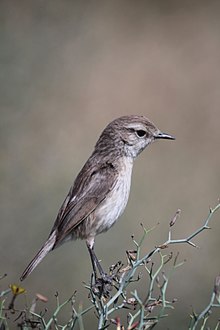Canary Islands stonechat
| Canary Islands stonechat | |
|---|---|

| |
| Male on Fuerteventura, Canary Islands, Spain | |
| Scientific classification | |
| Domain: | Eukaryota |
| Kingdom: | Animalia |
| Phylum: | Chordata |
| Class: | Aves |
| Order: | Passeriformes |
| Family: | Muscicapidae |
| Genus: | Saxicola |
| Species: | S. dacotiae
|
| Binomial name | |
| Saxicola dacotiae (
Meade-Waldo , 1889) | |
The Canary Islands stonechat (Saxicola dacotiae), also known as the Fuerteventura stonechat or Fuerteventura chat, and formerly known as the Canary Islands chat due to its once widespread distribution on the Canary Islands, is a sedentary resident bird found only on the island of Fuerteventura where it is known as the Caldereta.

Taxonomy
The Canary Islands stonechat is a small
Description
The Canary Islands stonechat is intermediate in appearance between the European stonechat and the whinchat; its body size and shape reminiscent of a lithe European robin. Its upperparts are generally coloured as the whinchat, but more contrasting, dark brown with a blackish head and back streaks. It has a purer white supercilium reaching behind the eye and white neck sides, and a light orangey-chestnut breast becoming duller and paler on the underside towards the whitish belly. The rump and tail are dark, the latter with a white pattern visible in flight. There is also a white wing band. The female is similar to a washed-out version of the male, with a brown, black-streaked head and no white neck patches.
The male has a ticking call like a pebble hitting another, and a high twittering song like a European stonechat.
Ecology
This Canary Islands stonechat is highly faithful to good
Laying 4-5 eggs per clutch and incubating for 13 days, it usually manages to raise two clutches of young a year.
Conservation status

This Canary Islands stonechat is now considered Endangered, as construction, mainly tourism-related, encroaches upon the best habitat (Illera et al., 2006). The population is hard to estimate, but most probably between 1300 and 1700 mature birds (BirdLife International 2004), and recognisably in decline. In particular, heavy land clearance on the Jandía peninsula is isolating the local subpopulation and making it vulnerable to adverse effects of small population size.
Desertification, exacerbated by grazing goats and locally sinking water tables, has also contributed to habitat loss. Feral cats and black rats prey on the eggs and young. A conservation action plan has existed for this species since 1999 (BirdLife International 2004). Due to its fairly high reproductive rate, if enough habitat is secured and predators are kept at bay, it should be able to hold its own.
The Chinijo chat,
References
- .
- ^ Collar, Nigel (2020). "Fuerteventura stonechat". Birds of the World.
- BirdLife International (2006): Species factsheet: Saxicola dacotiae Archived 2008-12-28 at the Wayback Machine. Retrieved 2006-DEC-12.
- Álamo Tavío, Manuel (1975). Aves de Fuerteventura en peligro de extinción. Las Palmas de Gran Canaria: Asociación Canaria para Defensa de la Naturaleza. pp. 10–32.
- Illera, Juan Carlos; Díaz, Mario & Nogales, Manuel (2006): Ecological traits influence the current distribution and range of an island endemic bird. (HTML abstract)
- Wink, M.; Sauer-Gürth, H. & Gwinner, E. (2002): Evolutionary relationships of stonechats and related species inferred from mitochondrial-DNA sequences and genomic fingerprinting. Brit. Birds 95: 349–355. PDF fulltext

